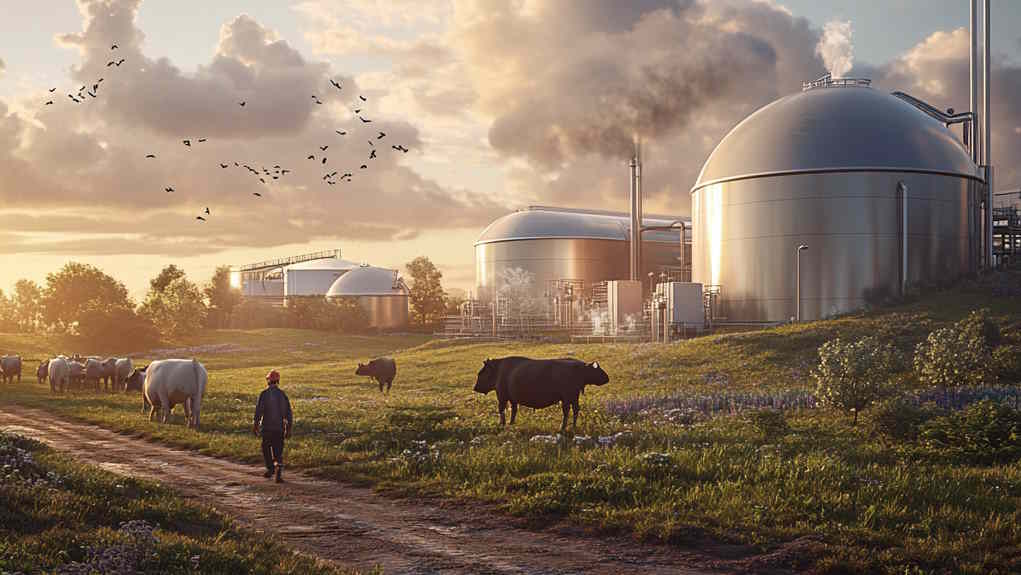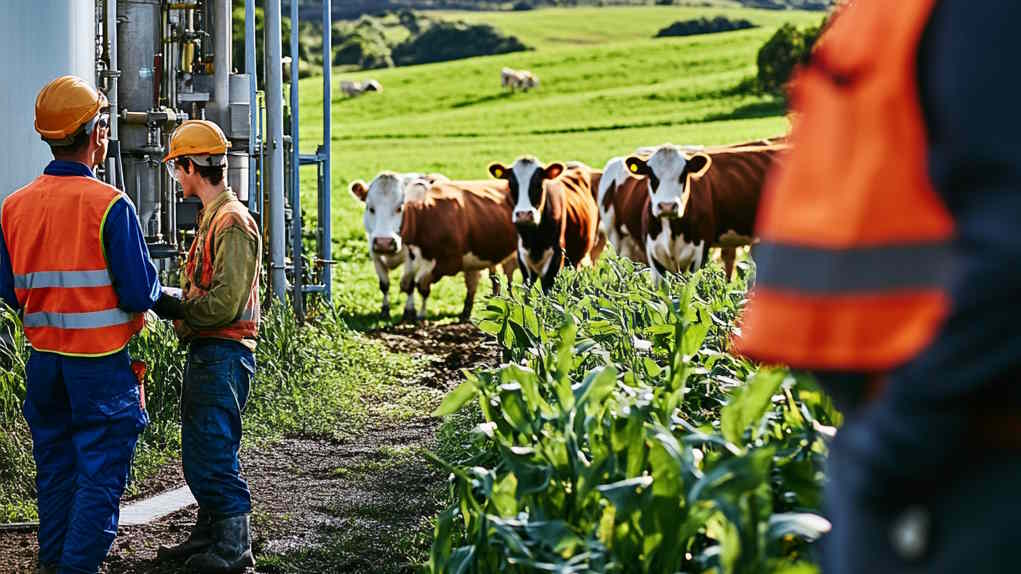Discover How Food Waste Energy is Transforming Sustainability
Many people are looking for ways to handle food waste better. Did you know 1.03 billion tons of food go to waste each year? This blog will show how turning food waste energy can tackle this problem.
Keep reading, and let's learn together.
Key Takeaways
- Every year, 1.03 billion tons of food gets wasted. Turning this waste into energy can reduce methane emissions from dumps and help fight climate change.
- Two main methods to convert food waste into energy are anaerobic digestion and biomass gasification. These processes create renewable energy like electricity and fuel.
- Using all U.S. food waste for renewable diesel could lower greenhouse gases by up to 2.6%. This shows using biowaste wisely helps our environment.
- Preparing food waste properly before turning it into energy is key to making the process efficient. It involves sorting, chopping, and sometimes adding bacteria.
- Converting food waste into energy improves how we manage waste, reduces harmful gases in our air, and lessens reliance on foreign oil sources.

The Potential of Food Waste for Energy Production
Moving from the introduction, we see that food waste holds great promise for making energy. Each year, 1.03 billion tonnes of food get thrown away. This is not just a big waste; it also hurts our planet by creating methane gas in dumps.
Methane gas adds to climate change and makes up 15.1% of the U.S.'s methane emissions.
I've seen how turning this waste into energy can do wonders. It keeps organic stuff out of landfills and cuts down methane creation. Also, it turns potential rubbish into something valuable: power for homes, heat, or even fuel for cars.
This kind of energy does not use oil from other countries and helps fight global warming.
Imagine all U.S. food waste turned into renewable diesel—that could cut greenhouse gas emissions by up to 2.6%. Plus, methods like biomass gasification turn food scraps into clean energy without burning fossil fuels which harm the air we breathe.
In my work with biogas production from organic rubbish at an anaerobic digestion plant, I've seen firsthand how this process works wonders—transforming leftovers into bio-methane that powers engines cleaner than petrol or diesel ever could.
Using what we throw away as a source of renewable energy surely paves a way toward a sustainable future by reducing our carbon footprint and supporting zero-waste goals.
Key Technologies for Converting Food Waste into Energy
Two main methods stand out for turning food waste into power: anaerobic digestion and biomass gasification. Anaerobic digestion breaks down organic matter without air, creating biogas that can be turned into electricity or heating.
Biomass gasification heats up organic materials at high temperatures with a controlled amount of oxygen, producing a mixture of gases—like hydrogen and carbon monoxide—that can fuel engines or turbines.
Anaerobic Digestion Methods
Anaerobic digestion methods turn food waste into biogas. This process uses tiny life forms that don’t need air to live. They break down food waste in a closed tank called an anaerobic digester.
Here, organic waste turns into methane and carbon dioxide gas, which we can use as energy sources.
This method helps fight climate change by lowering methane gas emissions from landfills. It turns waste into something useful - like electricity or heat for homes and businesses. By doing this, we also cut down on the need for foreign oil imports.
Plus, it makes handling waste better by not just throwing it away but using it to create renewable energy.
Biomass Gasification Techniques
Moving from anaerobic digestion, we explore biomass gasification techniques. This method turns food waste into syngas—a mix of hydrogen, carbon monoxide, and a bit of carbon dioxide.
It involves heating the waste without letting it burn completely. This way, we get a gas that can fuel things or make electricity.
I saw this process in action during a visit to a waste-to-energy plant. The system heated up garden and kitchen leftovers until they broke down into gases. Then, these gases were cleaned and used to power an engine or create heat for buildings.
It was impressive seeing trash turn into something so useful.
Biomass gasification helps us fight against landfill use and reduces harmful gases like methane from rotting food in dumps. By using rubbish as a resource, we're not just getting rid of waste; we're making energy that's clean and renewable.
This technique is smart because it tackles two big problems at once—waste management and finding more green energy sources.
Steps to Convert Food Waste into Sustainable Energy
Turning food waste into sustainable energy involves a series of clear steps. First, we need to prepare the food waste, breaking it down into smaller pieces using tools like the Drycake Twister separator.
This process makes sure that everything is ready for the next stage, where tiny life forms break down the waste in an oxygen-free space during anaerobic digestion. Here, we use digesters to turn organic material into biogas – a type of fuel gas.
Another method involves heating up the waste without burning it in biomass gasification techniques to produce synthesis gas, another kind of renewable fuel. These processes help us get energy from what was once just thrown away.
Pre-treatment Methods for Food Waste
Preparing food waste before turning it into energy is crucial. It makes the process more efficient and effective. Here are some methods used:
- Sorting out non-organic materials like plastic and metal using a machine called Drycake Twister separator. This step cleans the waste so it's ready for energy production.
- Chopping large pieces of waste into smaller ones. This helps microorganisms break down the food waste faster in the later stages.
- Removing excess moisture from wet food waste through a process called dewatering. It focuses on getting rid of water, which speeds up digestion.
- Adding certain bacteria to start breaking down the food waste quickly is known as inoculation. These bacteria are often taken from successful batches of past digestions.
- Adjusting the pH level to make conditions just right for bacteria that produce biogas. This might mean making the mix more acidic or basic, depending on what's needed.
- Blending different types of food waste together can improve biogas production. Some wastes have nutrients that others lack, creating a balanced diet for bacteria.
- Heating the pre-treated food waste gently prepares it for anaerobic digestion or gasification by activating helpful microorganisms.
From my experience working with these technologies, getting these steps right makes all the difference in how much energy you can get from your food waste later on. Each method helps turn what would have been thrown out into valuable renewable energy, while also reducing greenhouse gases like methane—a win-win for both us and the planet.
The Anaerobic Digestion Process
Anaerobic digestion of food waste turns unwanted leftovers into valuable energy. This process reduces methane emissions, which are harmful to our atmosphere.
- Collect all sorts of food scraps. From homes, restaurants, and farms, we gather bits that people don't eat.
- Sort the waste. We remove things that can't break down, like plastics and metals.
- Chop up the remaining food waste. Smaller pieces digest easier.
- Move the chopped waste into a digester tank—a big, sealed container that keeps air out.
- Inside the tank, micro-organisms start to break down the food waste without oxygen. This is called anaerobic digestion.
- These tiny life forms produce biogas—a mix of mostly methane and carbon dioxide.
- Capture this biogas carefully from the tank.
- Clean the biogas by removing unwanted chemicals and moisture so it's pure enough to use as fuel.
- Use this clean biogas in different ways—like generating electricity or powering vehicles.
Now let's look at how turning waste into energy helps manage it better and protects our planet...
Techniques for Gasification
Moving from the anaerobic digestion process, we now explore gasification techniques. This method turns food waste into clean energy. Here's how:
- Prepare the waste - Remove any non-organic materials from the food waste. This makes sure only suitable material goes into the gasifier.
- Heat it up - Food waste is heated at high temperatures in an environment with limited oxygen. This process does not burn the waste.
- Produce syngas - The heat breaks down the organic material, producing syngas. Syngas is a mix of hydrogen, carbon monoxide, and a little bit of carbon dioxide.
- Clean the syngas - Before using it as fuel, remove contaminants from the syngas. This step ensures it burns cleanly.
- Use for energy - The cleaned syngas can fuel power stations or be turned into biofuels for motor vehicles.
- Make biochar and fertiliser - Gasification also produces biochar, which can enrich soil for agriculture practices. In many ways this is better than windrow or in-vessel composting.
This process helps cut down methane emissions from food waste in landfills and replaces fossil fuels with renewable natural gas for a lower carbon future.
The Advantages of Food Waste Energy Conversion
Turning food waste into energy helps our planet in many ways. This process cuts down harmful gases that warm the earth, turns trash into useful power, and makes getting rid of waste better.
To learn more about how this works and why it's great for the environment, keep reading.
Reduce Environmental Impact
Utilising food waste for energy reduces methane gas emissions. Methane constitutes 15.1% of U.S. emissions from rubbish dumps. This alteration prevents organic materials from reaching landfills, where they would emit abundant methane into the atmosphere.
This approach goes beyond merely dealing with waste in a more eco-friendly way, it also assists in counteracting climate change and working in alignment with net-zero emissions objectives.
By transforming all U.S. food waste into renewable diesel, we could diminish the country's greenhouse gases by up to 2.6%. It exhibits how judicious use of biowaste can contribute to a healthier and safer environment for all.
Generate Renewable Energy
The practice of transforming food waste into a source of renewable energy is indeed a clever strategy. It aids in reducing the emissions of methane gas, which are detrimental to our planet.
Approximately 15.1% of methane in the U.S. emerges from decomposing food in landfills. By converting this waste into electricity, heat or vehicle fuel, we can reduce the reliance on foreign oil.
This transition promotes a cleaner environment and combats climate change.
Utilising all of the discarded food in the U.S to produce diesel could significantly reduce harmful gases by up to 2.6%. This translates into major advantages for our air and climate.
It not only removes organic materials from land dumping but also converts them into usable energy. Following this, we will examine how improved waste management can heighten this entire process.
Boost Waste Management Efficiency
Turning food waste into energy makes the process of getting rid of waste much better. It stops huge amounts of organic materials from just sitting in dumps where they can let out methane - a gas that's not good for our air.
This method is smart because it uses something we don't want - waste, and turns it into something we need - energy. With every tonne of food saved from landfills, we cut down on harmful gases and make our cities cleaner.
Machines like biodigesters take what we throw away and make biogas and bio-diesel. They work by breaking down the scraps without using oxygen. This way, less trash goes to dumps, reducing the space needed for them.
Energy made this way can power homes or cars without needing oil from other countries. Moving to these methods takes us closer to a world where nothing valuable gets thrown away but is used again in a sustainable cycle.
Next, let's explore how all these processes help our planet breathe easier by cutting down on bad gases in the air.
Conclusion
We've learned that food waste can fuel up our energy needs. Technologies like anaerobic digestion and gasification turn trash to treasure. Simple steps make these methods work well.
They cut pollution, create clean power, and help us manage waste better. Let's ask ourselves how we can use less and turn what we waste into energy. This move will clear the air, save resources, and support a green future for all of us.
Every small action counts in making our planet healthier.
FAQs
1. What is the process of generating renewable energy from food waste?
Generating renewable energy from food waste involves the use of anaerobic digestion plants or biogas digesters. These facilities convert organic wastes, including wasted food, into a renewable energy source known as biogas through a series of processes involving acidogenic bacteria and methanogens.
2. How does this form of waste disposal contribute to a sustainable lifestyle?
The conversion of food waste to energy helps reduce carbon emissions associated with traditional sources of energy such as fossil fuels. It also diverts organic wastes away from landfill sites, helping us move towards zero-waste goals and promoting a more sustainable lifestyle.
3. Can all types of food waste be used in these processes?
Most types can indeed be converted into bioethanol or biomethane via anaerobic digestion or pyrolysis. However, some materials might require pre-treatment before they can undergo acidogenesis and methanogenesis effectively.
4. Are there any by-products formed during this process?
Yes! The main by-product is called digestate which is rich in nutrients and can be used as a soil amendment for growing crops—making it an excellent example of renewables circularity!
5. Is converting food waste to energy considered carbon-neutral?
While no process is entirely without emissions, harnessing renewable alternative energies like biogas from food wastes significantly mitigates our carbon footprint compared to conventional fuel sources... making it an important step towards achieving carbon neutrality!
6. How does this technology fit into the broader picture for clean and renewable resources?
Energy recovery from municipal dumps and other forms of organic wastes contributes significantly to diversifying our sources of energy... This not only reduces reliance on non-renewable resources but also aids in combating climate change by reducing greenhouse gas emissions!



